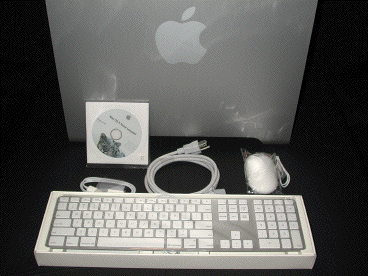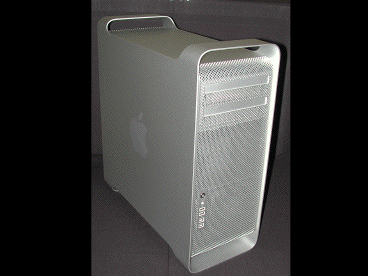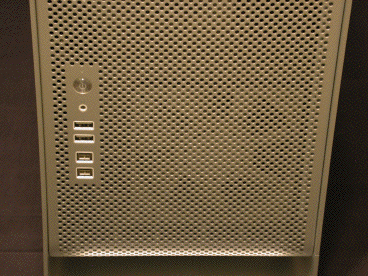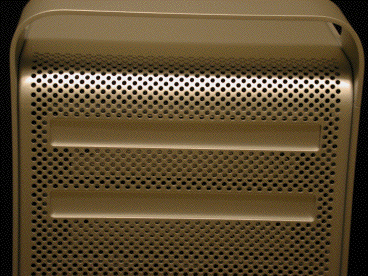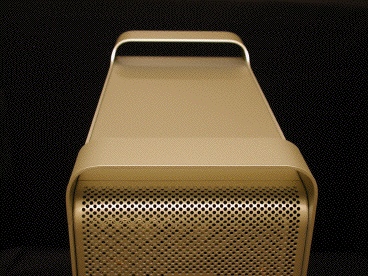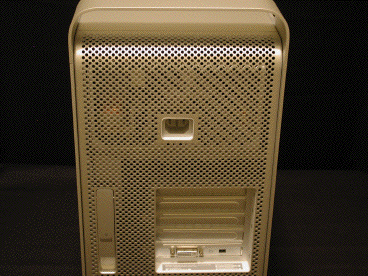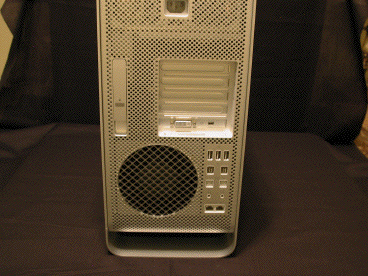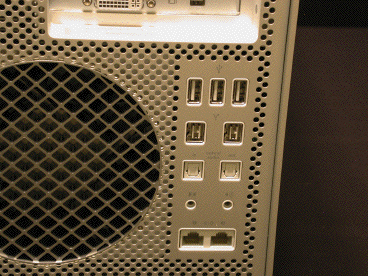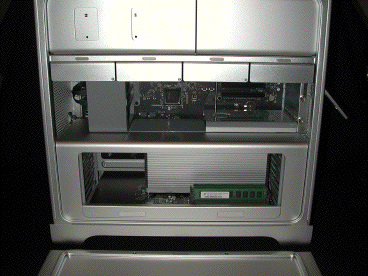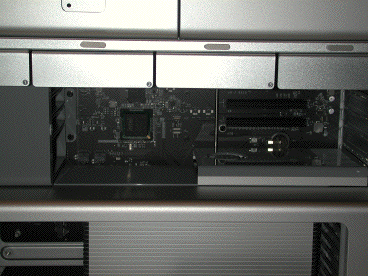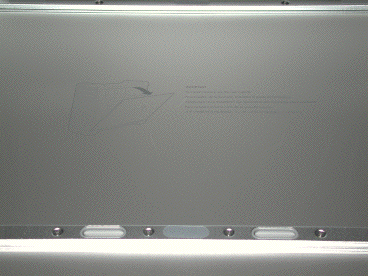Review: 2009 Mac Pro
by Charles W. Moore & Steve Hildreth
Apple's professional models in desktop tower configurations date back to the Motorola 25 MHz 68040 powered Macintosh Quadra 700 introduces way back in October, 1991 (along with the original PowerBooks), and there have been professional Mac towers available continuously since then.
Apple introduced their next-generation Pro desktop system at WWDC 2006 in August. Updated to its current configuration in March 2009, the Mac Pro is an Intel-based system using one 2.66GHz Quad-Core Intel Xeon CPU and offers 8MB shared L3 cache per processor, 3GB memory, NVIDIA GeForce GT 120 graphics with 512MB memory, 640GB Serial ATA 3Gb/s 7200-rpm hard drive, and a 18x double-layer SuperDrive. It's available today at The Apple Store for $2499. The Mac Pro is available with configure-to-order options including a choice a 2.93GHz processor, up to 16GB of RAM, 4TB of storage, dual optical drives, and multiple graphics cards.
For $3299, a model with two 2.26GHz Quad-Core Intel Xeon "Nehalem" processors is available. This unit ships with 6GB RAM, upgradeable to 32GB.
Apple claims that there are more than a mind-boggling 4.9 million possible configurations for the Mac Pro.
Even the base configuration of these big tower machines is an awesome powerhouse, the expandability can take you into the stratosphere (eg: up to two 2.93GHz GHz Quad-Core Xeon CPUs, 32GB of RAM, up to 4TB of internal storage, four video cards, two SuperDrives, Xserve support, RAID, hot swappable drives, and remote management while running Mac OSX Server).
As Apple did with all of their first generation Intel machines, save for the MacBook which replaced the five year old dual USB iBook, they chose to stick with essentially the form factor of the preceding Power PC model. While the Mac Pro case design carried over from the Power Mac G5s with a few minor changes (ie: a second optical slot in the front, a FireWire 800 connector, only one fan in the back of the Mac Pro, vs. two in the G5 Power Mac) is handsome enough, a more distinctive makeover in form factor might have been in order, but would have caused a longer delay in getting the big MacIntels out. On the other hand, the "if it ain't broke; don't fix it" maxim can be applied.
The Mac Pro features Intel's Dual-Core Intel Xeon series processor based on Core microarchitecture, with two Quad-Core Intel Xeon processors running up to 2.93GHz GHz, each with 6MB of shared L3 cache and independent buses.
Other Mac Pro features include a new, direct attach storage solution for cable free, snap in installation of up to four Serial ATA hard drives for a total of 4TB of internal storage - a new storage high-water-mark for Macs - and support for two optical drives to simultaneously read and/or write to CDs and DVDs.
Also included are three full-length PCI Express expansion slots and one double-wide PCI Express graphics slot to support double-wide graphics cards without clogging up multiple slots.
These Mac Pros come standard with the NVIDIA GeForce GT 120 graphics processing unit (GPU) with 512MB of video memory, providing built-in support for dual-displays and Apple's 30-inch Cinema HD Display. The ATI Radeon HD 4870 with 512MB of video memory is available as build to order options and provides built-in support for up to two 30-inch Apple Cinema HD Displays. The Mac Pro includes a stereo 3D port to connect goggles for stereo-in-a-window applications and is ideal for the most demanding animation, special effects, and scientific visualization applications. If you need the power, the Mac Pro supports up to four PCI Express graphics cards to drive up to eight displays at once for advanced visualization and large display walls.

The Mac Pro front panel sports convenient access to a FireWire 800 port, a FireWire 400 port, and two USB 2.0 ports with additional FireWire 800, FireWire 400, and three USB 2.0 ports on the back panel. The port array also includes two Gigabit Ethernet ports, optical digital input and output, analog audio input and output, with built-in support for AirPort Extreme and Bluetooth 2.0+EDR optional. Sadly, there is no internal modem offered.
View a short walk-through of the 2009 2.66GHz Mac Pro:
Quick and convenient access to internals has been a signature feature in professional tower Macs since the Blue & White Power Macintosh G3/300-450 tower was introduced at Macworld Expo San Francisco in 1999. The Mac Pro continues the tradition, with one whole side of the tower case removable at the flip of a lever, plus a newly designed bracket for tool-less installation and removal of expansion cards.
Given all that is included with the Mac Pro, we were a little surprised that an internal AirPort wireless WIFI card is not included in the price of the base 2.66GHz model we tested. Turns out it's a $50 option. We also think the power cord could be a little longer. It's a big and heavy tower that comes in a very large box along with a wired mouse and a wired extended keyboard. Scores from Primate Lab's Geekbench show that even the base Mac Pro outpaces the rest of Apple's current lineup by a wide margin:
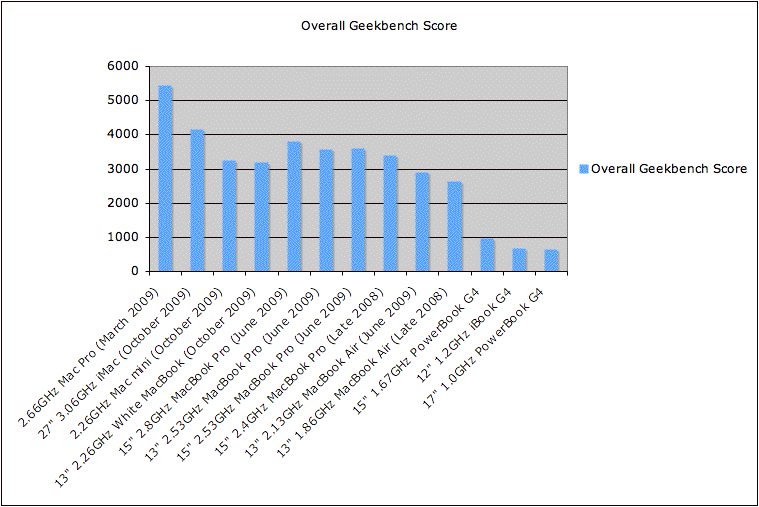
The Mac Pro is the most powerful, expandable computer Apple has ever offered, and if raw computing performance and versatile expandability in a Mac OS machine is what you need, look no further. The main criticism is that at an entry-level $2499, the Mac Pro is a bit pricey compared with some of the PC competition (although it's a lot cheaper than that first Quadra 700 that sold for $6,000 without a keyboard), and if mail I receive is any measure, there would be a ready market for a somewhat less capable, less expensive professional desktop Mac offering more versatility and expansion than the high-end iMacs and selling for $1,699 or so. That, and even though it's offered free of charge on even the lowliest of Macs, be prepared to cough up an extra 50 bucks to go wireless.
